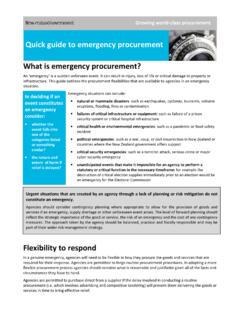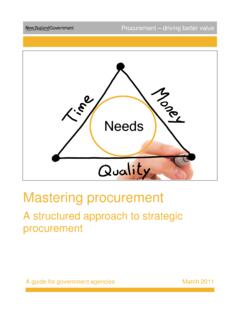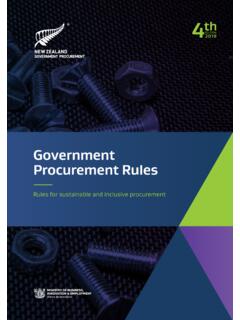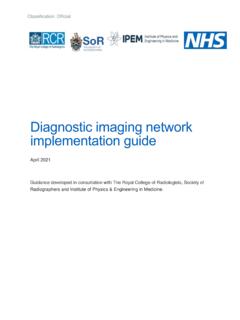Transcription of Developing your construction procurement strategy ...
1 NEW ZEALAND GOVERNMENT procurement MINISTRY OF BUSINESS, INNOVATION & EMPLOYMENT HIKINA WHAKATUTUKI Developing your construction procurement strategy construction procurement Guidelines October 2019 New Zealand Government construction procurement Guidelines The purpose of the construction procurement Guidelines is to provide government agencies with guidance on the government s standards of good practice for the development of their construction procurement strategy . The Guidelines are intended to support government agencies to improve the quality and consistency of their construction procurement practices.
2 The Guidelines consist of a suite of sections, each covering a subject matter area. They are considered to be live documents which we may update and add to, from time to time, to ensure they remain current and relevant. You can download the latest version of each section, along with any accompanying tools and templates, from To provide feedback on the Guidelines, email Major infrastructure project guidance Major infrastructure projects by their very nature are large scale and complex they have bespoke issues, risks and challenges that may require more sophisticated project planning, management, procurement and governance approaches. The New Zealand Infrastructure Commission -Te Waihanga, publishes major infrastructure guidance for projects with a total cost of ownership of greater than $50m. For more information about major infrastructure project guidance and the support provided by the Infrastructure Commission, see or contact the Infrastructure Commission at Disclaimer The information presented in this guideline is intended for general use only.
3 It should not be construed as legal advice, and should be read in conjunction with any relevant policy, legislation and regulations. While every effort has been made to ensure the accuracy, currency and completeness of this guideline, the Ministry of Business, Innovation and Employment (MBIE) cannot accept any liability for the accuracy, currency or completeness of material contained herein. MBIE cannot be held responsible for, and makes no warranties as to: the suitability of the information in this guideline for your specific circumstances; or any actions taken by third parties as a result of you relying on information contained in this guideline. Version released October 2015 Version released October 2016 Version released October 2019 ISBN 978-1-99-000434-6 (Online) New Zealand Government procurement PO Box 1473 | Wellington 6140 | New Zealand | Unless otherwise indicated for specific items or collections of content, this work is licenced under the Creative Commons Attribution International License.
4 In essence, you are free to copy, distribute and adapt the material, as long as you attribute it to Ministry of Business, Innovation and Employment and abide by the other terms of the licence. The permission to reproduce material in this work does not extend to any material that is identified as being protected by copyright owned by a third party. This includes material on websites you may access via links from, or footnotes to, this work. We cannot grant permission to reproduce such material: you must obtain permission directly from the copyright owner(s). Please note that this licence does not apply to any logos, emblems, trade marks, photography and imagery in this work. These specific items may not be re-used without express permission. If you wish to reproduce any images in this work, please contact us at Contents Developing your construction procurement 4 4 Steps to Developing your procurement strategy .
5 4 Context .. 6 Gather and analyse project information .. 7 Project requirements .. 7 Project 8 Project risks .. 9 Client capability .. 9 Market position .. 10 Determine preferred delivery model .. 11 Types of delivery 11 Identifying a preferred delivery model .. 13 Plan the approach to 15 Tender process .. 15 Contract price mechanism .. 15 Type of contract .. 17 s NEW ZEALAND GOVERNMENT procurement Within this guide, cllent means the public sector agency that procures and delivers the project. procurement strategy relates to the process for considering and deciding the most appropriate delivery model and approach to market for a specific project. The procurement strategy should be documented, to clearly demonstrate how an agency has evaluated the available options and arrived at a best-fit solution. There's no universal template for use, however, a good procurement strategy should contain at a minimum the items as highlighted below in Components of a good procurement strategy .
6 procurement plan is the execution plan for delivering the procurement strategy during the sourcing phase of the procurement lifecycle. It should address matters such as: > governance > key stakeholders and their responsibilities > budget management > tender dellverables > timelines and milestones > probity requirements > tender evaluation requirements. PLAN APPROACH TO MARKET Developing your construction procurement strategy Overview A robust, documented procurement strategy , based on facts and analysis, is an important part of planning the successful delivery of your capital project. A procurement strategy is developed during the planning phase of the procurement lifecycle. One of the key objectives of a procurement strategy is to assess a range of delivery options and identify a recommended delivery model . By assessing a range of options, you can maximise value and optimise project outcomes. The procurement plan follows on from the procurement strategy document, providing the methodology, approach, process, and project management structure for sourcing and managing your suppliers.
7 Steps to Developing your procurement strategy The process of Developing a procurement strategy can be divided into three steps: Although this process is shown as sequential, these steps may also be repeated as the project progresses, circumstances change, and more information becomes available. It can be developed in parallel with your business case. construction procurement GUIDELINES 4 Developing YOUR construction procurement strategy s NEW ZEALAND GOVERNMENT procurement Components of a good procurement strategy Statement of objectives Summary and analysis of: project objectives requirements characteristics risks Review of client and market capabilities An analysls of dellvery model options and Identification of a recommended delivery model Analysis of potential procurement methods and identification of a recommended method Description of how whole-of-life outcomes will be delivery Summary of market engagement strategy Summary of approach to.
8 Risk management health and safety incorporating broader outcomes construction skllls and training sustainable construction Building Information Modelling (BIM) A project plan showing timing and sequence Client contract management requirements Opportunities for bundling or unbundling work and contracts, for example: bundling projects of a similar nature to increase economies of scale, or splitting contracts where speed is a high priority, such as enabling, groundworks and main contract. Note: The level of detail for each can be tailored to the scale and complexity of your project. procurement strategies for projects that are low- risk and low-value may not require all these elements. construction procurement GUIDELINES 5 Developing YOUR construction procurement strategy s NEW ZEALAND GOVERNMENT procurement Key success factors when Developing an effective procurement strategy > Fully understand the project characteristics including key drivers, constraints and risks.
9 > Assess client and market, capabilities and capacity. > Evaluate potential delivery models and approach to market for suitability. > Involve key stakeholders and experts early in the planning and development process. > Challenge assumptions in order to better achieve desired outcomes. > Use practical analytical techniques to support the decision-making process. Context This focus area assumes that you have developed or are Developing a business case that indicates new construction work, or construction work involving refurbishment of an existing asset, is needed. It describes what MBIE considers good practice when you develop a procurement strategy for a construction project. It provides basic guidelines on the types of delivery models available, how to go about assessing which model may be the best fit for your project, and the issues to consider when planning your approach to market. This guide is not a substitute for professional advice.
10 It helps inform you about some of the key issues to address when you develop a procurement strategy for a construction project. If you require more information and advice on procurement of construction projects, contact MBIE at construction procurement GUIDELINES 6 Developing YOUR construction procurement strategy Gather and analyse project information The first step involves gathering and analysing relevant project information to establish a good understanding of your project characteristics in the following key areas: Project requirements Project constraints Project risks Client capability Market the project s unique characteristics will enable you to identify the appropriate evaluation criteria, and their weightings, and decide on the best project delivery option. The project brief is a useful source of information. The following tables will also help you with some of the questions key to determining your project s characteristics.






